Data Communication and Networking | Computer Awareness and Proficiency - SSC CGL PDF Download
| Table of contents |

|
| Communication |

|
| Data Communication |

|
| Communication Channel |

|
| Communication Media |

|
| Computer Network |

|
| Network Topology |

|
| OSI Model |

|
| Terms Related to Computer Network |

|
Communication
Communication involves the sending or receiving of information. It encompasses the sharing of information or data between individuals or devices.
Communication System
A communication system is a collection of hardware and software designed to facilitate the exchange of information between different devices within a network.
Data Communication
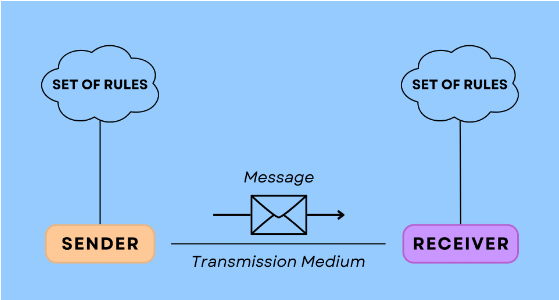
Data communication refers to the exchange of data between two devices through some form of transmission media. This process involves not only the transfer of data or information but also the preservation of data integrity during transmission. Data is typically transferred in the form of signals from one location to another.
Types of Signals:
- Digital Signal: Data is transmitted electronically as binary digits (0 or 1).
- Analog Signal: Data is transmitted as radio waves, such as in telephone lines.
- Hybrid Signal: These signals possess characteristics of both digital and analog signals.
Components of Data Communication
When discussing communication between two devices using a network, five key components are essential:
- Sender: A device capable of sending data over a network, such as a computer, mobile phone, smartwatch, walkie-talkie, or video-recording device.
- Receiver: A device capable of receiving data from the network, such as a computer, printer, laptop, mobile phone, or television. Both sender and receiver are referred to as nodes in a network.
- Message: The data or information that needs to be exchanged between the sender and receiver. Messages can be in various forms, including text, numbers, images, audio, video, or multimedia.
- Communication Media: The pathway through which the message travels from the source to the destination. This medium, also known as a transmission medium or link, can be either wired or wireless.
- Protocol: A set of rules that the communicating parties must follow to ensure successful and reliable data communication.
Characteristics of Data Communication
- Delivery: Data must be delivered from the source to the correct destination in the right order.
- Accuracy: Data must be transmitted without errors. Any inaccuracy during transmission should prompt re-transmission of the data.
- Timeliness: Data must be delivered within a specified time period, as late data may become useless.
Communication Channel
The communication channel refers to the direction of signal flow between two connected devices. There are three main types of communication channels:
Simplex Channel: Data flows in only one direction, with no capability to support a response in the other direction. This type of communication is uni-directional, where one device transmits information, and the other can only receive it. Examples include radio, television, and keyboards.
Half Duplex Channel: Data can flow in both directions, but not simultaneously. When one device transmits information, the other can only receive at that time. An example is a walkie-talkie.
Full Duplex Channel: Data flows in both directions simultaneously, allowing both stations to transmit and receive information at the same time. An example is a mobile phone.
Communication Media
Communication media, or transmission media, refers to the physical paths that carry information from a source to a destination within a network. It can be categorized into two main types:
Guided Media (Wired Technologies): Data signals are guided along a specific path by a cabling system, which can be composed of metals like copper, tin, or silver. The main types of guided media are:
- Ethernet Cable (Twisted Pair Cable): Wires are twisted together and insulated, with an outer jacket. One wire carries signals to the receiver, and the other serves as a ground reference. Commonly used in local area networks.
- Co-axial Cable: Carries higher frequency data signals through a single inner conductor that transmits electric signals, while the outer conductor acts as a ground. Used in cable TV networks.
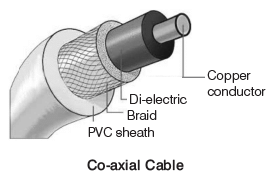
- Fiber Optic Cable: Made of glass or plastic, it transmits signals as light from one end to another. Optical fibers allow transmission over long distances at higher bandwidths, unaffected by electromagnetic fields, and are much faster than co-axial cables.

Unguided Media (Wireless Technologies)
Data is transmitted through waves without using enhanced electrical conductors or wires. Common types of unguided media include:
- Radiowave Transmission: Communication using radio frequencies, ranging from 3Hz to 1GHz. These waves are omni-directional and can travel long distances, especially those that propagate in the sky mode.
- Microwave Transmission: Electromagnetic waves with frequencies ranging from 0.3 to 300 GHz. Microwaves are uni-directional and have higher frequencies than radio waves. Used in cellular networks and television broadcasting.
- Infrared Wave Transmission: High-frequency waves used for short-range communication, ranging from 300 GHz to 400 THz. These waves cannot pass through solid objects and are used in TV remotes and wireless speakers.
- Satellite Communication: Combines radio frequency transmission with satellites to facilitate communication over long distances. Used for communication with ships, vehicles, planes, and handheld terminals.
Additional Communication Technologies
- Bluetooth: A short-range wireless communication technology that allows devices such as mobile phones, computers, and peripherals to transmit data or voice wirelessly over short distances.
Computer Network
A computer network is a collection of two or more computers connected to share information and resources. It involves both hardware and software that enable communication over the network.
- ARPANET: Stands for Advanced Research Projects Agency Network. It was the first network developed by Vint Cerf in 1969.
Benefits of Computer Networks
- File Sharing: Allows users to share data and files.
- Hardware Sharing: Enables the sharing of devices such as printers, scanners, CD-ROM drives, and hard drives.
- Application Sharing: Supports the implementation of client/server applications over the network.
- User Communication: Facilitates communication using email, newsgroups, video-conferencing, etc.
Types of Computer Networks
- Local Area Network (LAN): A small, single-site network connecting devices over a relatively short distance, such as within a home, office, building, or school. Speed can reach up to 1000 Mbps. LANs are typically owned and managed by a single entity and use technologies like Ethernet and Token Ring.
- Wide Area Network (WAN): A geographically dispersed collection of LANs, often spanning the world, such as the Internet. Speed can reach up to 150 Mbps. WANs use technologies like ATM, Frame Relay, and X.25.
- Metropolitan Area Network (MAN): A network designed for a town or city, covering a larger area than a LAN but smaller than a WAN. Speed can reach up to 100 Mbps. An example is a cable TV network.
- Personal Area Network (PAN): A small network for personal use, covering a limited range. Speed can reach up to 3 Mbps. Examples include Bluetooth, Wireless USB, Z-Wave, and ZigBee.
Network Servers
- Server: A system that responds to requests across a computer network to provide a network service. It is typically run on a dedicated, powerful computer.
- File Server: A type of server that provides access to files, allowing users to share programs and data over a LAN.
Computer Network Devices
These devices are essential for amplifying signals to restore their original strength and providing interfaces to connect multiple computers within a network. Several types of computer network devices are used in networking, including:
- Repeater: A device with two ports that connects two segments of a LAN. It amplifies signals transported over long distances, boosting them back to their original strength.
- Hub: Similar to a repeater but with multiple ports, it connects network channels. Acting as a centralized connection point for multiple computers, it receives a data packet at one port and transmits it to all other ports.
- Gateway: An interconnecting device that joins two different network protocols, also known as protocol converters. It accepts packets formatted for one protocol and converts them to another. Gateways serve as nodes that act as proxy servers and firewalls, preventing unauthorized access.
- Switch: A small hardware device that connects multiple computers within a LAN, reducing overall network traffic. Unlike hubs, switches forward data packets to specific recipients by establishing temporary connections between the source and destination.
- Router: A device designed to take incoming packets, analyze them, and direct them to appropriate locations. Routers move and convert packets to different network interfaces, drop packets, and direct packets to their destinations.
- Bridge: Functions similarly to switches by filtering data traffic at a network boundary. Bridges reduce LAN traffic by dividing it into two segments. Traditional bridges support one network boundary, while switches, often called multiport bridges, typically offer four or more hardware ports.
- Modem: Converts digital signals to analog signals (modulator) at the sender’s end and analog signals back to digital signals (demodulator) at the receiver’s end, enabling communication via telephone lines. Modems are placed between a telephone line and a computer.
Network Topology
Network topology refers to the layout of a network, either physically or logically. It describes the geometric arrangement of a computer system, where each computer system is known as a node. Common network topologies include:
- Bus Topology: All nodes are connected to a single line, typically used for small, simple, or temporary network installations.
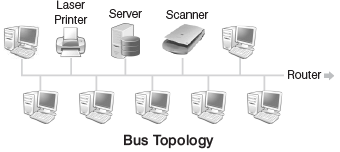
- Star Topology: Peripheral nodes are connected to a central node, which re-broadcasts transmissions from any peripheral node to all others. This topology can be expanded by adding another star hub.
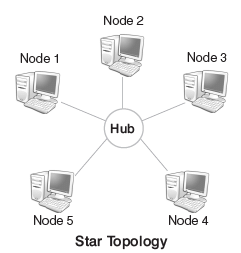
- Ring (Circular) Topology: Used in high-performance networks requiring large bandwidth, it transmits data in the form of tokens over a network. Protocols include Token Ring and Fiber Distributed Data Interface (FDDI).
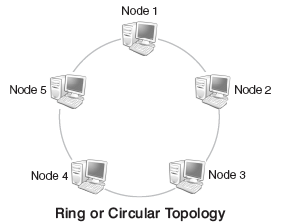
- Mesh Topology: Also known as completely interconnected topology, every node has a dedicated point-to-point link to every other node.
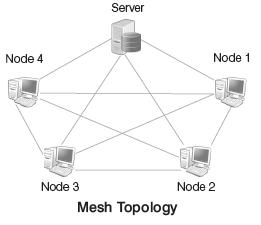
- Tree Topology: Nodes are arranged like an inverted tree, where the root acts as a server. This allows more devices to be attached to a single hub, distributing the function of the central node.
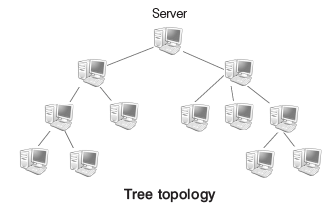
Models of Computer Networking
There are two primary models of computer networking:
Peer-to-Peer (P2P) Network: Relies on computing power at the edges of a connection rather than within the network itself. Used for sharing digital content like audio, video, and data, P2P connections involve connecting computers via USB to transfer files. In P2P networks, each computer can function as a server or client.
Client-Server Network: Involves interaction between two application programs where the client requests a service from the server. This network architecture separates the client from the server and is scalable, with one computer acting as the server and others as clients. Here, the client is the active device, while the server behaves passively.
OSI Model
- Open System Inter-connection (OSI) is a standard reference model for communication between two end users in a network.
- In 1983, the International Standards Organisation (ISO) published a document called Basic Reference Model for Open System Inter-connection, which visualises network protocols as a Seven Layered Model.
- OSI is a layered framework for the design of network system that allows communication between all types of computer systems.
- It mainly consists of seven layers across a network.
The OSI model's layers are:
- Physical Layer: The lowest layer, responsible for hardware and software implementation.
- Application Layer: The highest layer, focusing on end-user interface and applications.
Seven Layers of OSI Model and their Functions

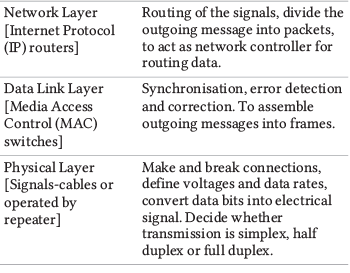
Computer Network Addressing
Network addresses are logical, software-based addresses that can be modified through proper configurations. These addresses identify hosts, nodes, servers, or entire networks. Configured on the network interface card, network addresses are typically mapped to the machine's MAC address for layer-2 communication. Types of network addresses include IP, IPX, and AppleTalk.
Terms Related to Computer Network
Multiplexing: A technique for transmitting multiple signals simultaneously over a common medium, utilizing a single path and multiple channels for data communication.
Code Division Multiple Access (CDMA): A channel access method used in various radio communication technologies. CDMA employs spread spectrum technology and a unique coding scheme, assigning a code to each transmitter to allow multiple users to share the same physical channel.
Packet Switching: A method of digital networking communication that combines all transmitted data into suitably sized blocks known as packets, regardless of content, type, or structure.
Public Switched Telephone Network (PSTN): A traditional telephone network requiring modems for data communication, also used for FAX machines.
Integrated Services Digital Network (ISDN): A network used for voice, video, and data services, utilizing digital transmission and combining both circuit and packet switching.
Ethernet: A widely used networking technology employing a bus topology. An Ethernet LAN consists of a single coaxial cable called Ether, operating at 10 Mbps and providing a 48-bit address. Fast Ethernet operates at 100 Mbps.
Token: A small message passed between stations to control network access.
Tit-Bits
- Bandwidth is like a speedometer for data, measured in CPS (Cycle Per Second) or Hz (Hertz).
- Throughput shows how much data moves between two computers, measured in bps (bits per second).
- Gbps (Giga bits per second) is the fastest data speed.
- GPS (Global Positioning System) is a worldwide navigation system for location, speed, and time sync. It's in your car, phone, and watch.
|
48 videos|44 docs|33 tests
|
FAQs on Data Communication and Networking - Computer Awareness and Proficiency - SSC CGL
| 1. What is the importance of data communication in computer networks? |  |
| 2. What are the different types of communication channels used in computer networks? |  |
| 3. How does network topology affect the performance of a computer network? |  |
| 4. What is the OSI model and why is it important in data communication and networking? |  |
| 5. Can you explain the role of communication media in computer networks? |  |















